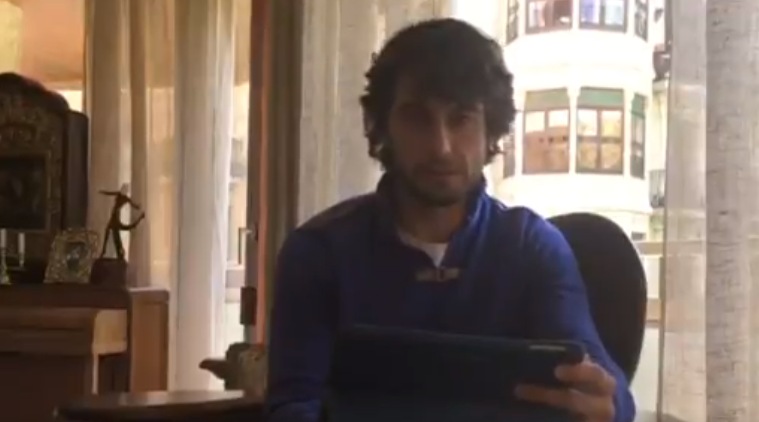 Juan Ferrando became the new manager of FC Goa after a video interview from his home in Barcelona. (Twitter/FCGoaOfficial)
Juan Ferrando became the new manager of FC Goa after a video interview from his home in Barcelona. (Twitter/FCGoaOfficial)
In the third week of March, when Spain was surpassing China’s Covid toll, Juan Ferrando got ready to appear for an interview from his home in Barcelona. The football coach’s prospective employers were thousands of kilometres away, bracing for a lockdown that would bring their club to a standstill.
Ferrando, who was a part of the legendary Arsene Wenger’s support staff at Arsenal, shared his vision and style for the club, and assessment of the players — and the employers scrutinised every point he made. After several hours, the deal was closed: Ferrando became the new manager of FC Goa.
This wasn’t the original plan, though.
The senior club management was to fly over to Spain, meet Ferrando, possibly watch a match, and then look at a future together. “Instead, we finished everything online,” says football agent Varun Achreja, who brokered the deal. “Everything is moving digital at the moment.”
So much so, that instead of scurrying from one ground to another in different parts of the world, club officials and representatives have shifted to e-meeting apps like Zoom and relying on scouting resources like InStat and Wyscout.
In India, June is the time when the modest transfer market springs to life. Old contracts expire on May 31, the transfer window opens in the first half of June, and by the time it shuts on August 31, crores are spent on hundreds of deals. This time, while data and scouting reports on Indian players are available, filling the foreign quota has become tricky. “I spend the summer travelling to different countries to scout players or have a look at some who are already on my shortlist. This time, it has not been possible,” says Mandar Tamhane, the chief executive of former ISL champions Bengaluru FC.
Club officials are just one part of the chain. Often, they have representatives on the ground, who crisscross cities to watch a prospective signing in action. For instance, Kuldeep Sharma, who has been responsible for several big-ticket transfers in Indian football, ends up watching about 100-125 matches a year across the world.
Sharma prefers live action and meeting players directly to understand their personalities and mindset, all valuable components in determining a transfer deal. This summer, says Sharma, “there has been a lot of reliance on digital communication and online resources to scout players and negotiate deals”.
Scouting resources
The online platforms provide scouts, agents and club officials with hundreds of hours of video and stats of almost any professional player. But as they now realise, conducting the transfer business online isn’t always the best way. The data equips them with information about a player’s skills — strong header, weak left foot, quick on the wings, etc — but there are a lot of “intangibles involved that can only be assessed when you meet a player in person”, says Tamhane.
So even if there is a shift to online, some of the basics remain the same. “You develop a good set of networks, verify the players’ potential with his teammates or coaches and go by recommendations,” says Sharma.
There is also an element of luck.
For example, one of the most prolific strikers to have played in India, Venezuela’s Miku, would never come to these shores had clubs relied only on online mediums.
The story goes that in the summer of 2017, Bengaluru FC had actually gone shopping for another player, Manucho. The Angolan striker was playing for Spanish club Rayo Vallecano at the time but it was Miku, his teammate, who caught their attention. Miku was in a different class, and in the 2016-17 season he was named La Liga’s Player of the Month ahead of the Ronaldos and Messis and Suarezs.
Tamhane casually met Miku in the stadium’s car park after the match. One thing led to another and a few months later, Miku was in Bengaluru, stamping his class in the ISL. “So you can use online resources, but it is not the same. Of course, in the current situation it is not possible to travel so you have to deal with the situation accordingly,” Tamhane says.
The clubs, however, are cautious. So far, a majority of the deals involving foreign players have either been contract extensions or movement from one club to another. This trend is unlikely to change immediately, as the All India Football Federation is set to give the clubs time till October to sign players.
The Indian transfer market is peculiar, in the sense that there are few actual transfers where a fee is paid, and clubs are often on the lookout for players who are out of contracts. “So this time, you might see a lot of clubs wait to see how the situation evolves in Europe and elsewhere in the world,” says Ashish Shah, who has been at the helm at Chennaiyin and Odisha.
The contracts of a foreigner in ISL range from anything between $70,000 and $500,000 a year. And with each franchise having a salary cap of Rs 16.4 crore, the clubs are hoping to land “bargain buys” in case a lower division club in Europe goes bust or the rates of players fall.
With the domestic season likely to begin only in November, there is still time for clubs. “And till we can meet, we will watch videos of the players and monitor them on WhatsApp,” says Ferrando, 39. “We have to use the technology.”